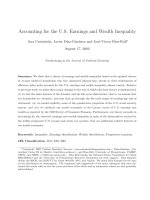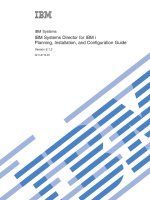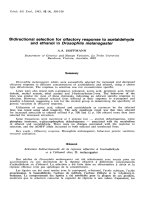ART-INTEGRATED PROJECT FOR CLASSES I TO X AND REPORTING OF IMPLEMENTATION OF ART- EDUCATION AND ART-INTEGRATED LEARNING BY SCHOOLS
Bạn đang xem bản rút gọn của tài liệu. Xem và tải ngay bản đầy đủ của tài liệu tại đây (1.75 MB, 19 trang )
<span class="text_page_counter">Trang 1</span><div class="page_container" data-page="1">
1
CBSE/Dir(Acad)/2020/ <b> 14</b>
<b><small>th </small></b><b>May, 2020 Circular No.: Acad 33/2020</b>
The Heads of all Schools Affiliated to CBSE
<b>Subject: Art-Integrated Project for Classes I to X and Reporting of Implementation of Art- Education and Art-Integrated Learning by Schools</b>
Dear Principal,
The Board, vide Circular No. Acad-05/2019 dated 18 January, 2019, mandated Learning Outcome (LO) Based Teaching-Learning process in all its affiliated schools. It was also informed that all schools must adopt and implement LOs prepared by NCERT in their annual pedagogical plans to enable all stakeholders to follow Competency Based Education (CBE). The underlying focus of CBE is attainment of each of the grade and subject appropriate LOs and demonstration and application of learning in real-life situation by the learners. CBE can be implemented only through innovative and joyful experiential
<i>pedagogies such as Art-Integrated and Sport-Integrated Learning, Storytelling, etc. which </i>
promote reflection, critical thinking, creativity, initiation, self-direction and other 21<small>st</small> Century Skills. All this is done to make students 21<small>st</small> century-ready citizens, by empowering them with the competencies to understand, analyse, evaluate, interpret and innovate various real life situations that they require to face in the world outside the classrooms or an environment beyond their schools and homes.
2. The Draft National Policy of Education 2019 inter-alia states: Art-Integration is a
<i>cross-curricular pedagogical approach that utilizes various aspects and forms of art and culture as the basis for experiencing the learning of concepts across subjects. As a part of the </i>
<i><b>thrust on experiential learning, art-integrated education will be embedded in classroom transactions not only for creating joyful classrooms, but also for imbibing the Indian ethos through integration of Indian art and culture in the teaching and learning process at every level. This art-integrated approach will strengthen the linkages between </b></i>
<i>education and culture. </i>
3. As a pedagogical initiative, CBSE has introduced Art- Integrated Learning in all its affiliated schools vide Circular No. Acad-12/2019 dated 8<small>th</small> March 2019. The Board has also issued
<i>Guidelines on Art-Integrated Learning vide Circular No. Acad-22/2019 dated 18.04.2019 </i>
with an aim to facilitate teachers and principals for implementing Art Integrated Learning as a pedagogical tool for experiential and joyful learning in classroom situation as well as building a joyful learning environment in the school. The Art-Integration guidelines of the Board enlists various suggestive activities, projects, assignments and lesson plans and are available at –
class="text_page_counter">Trang 2</span><div class="page_container" data-page="2">
2
<b>4. Art-Integrated Project for Classes I to X </b>
In continuation of above efforts, it has been decided to introduce Art-Integrated Project work for classes I to X to promote Art-Integrated Learning in schools to make teaching-learning Competency-Based and joyful. As part of this, at least one Art-Integrated Project in each subject shall be taken up by all students of classes IX and X from the academic session 2020-21, and students of classes I to VIII will also be encouraged to take at least one Art-Integrated Project (trans-disciplinary project) in a given academic year.
Art Integrated Project may be conducted as per the following guidelines:
4.1
Classes I–VIII, Art Integrated Project should be of trans-disciplinary nature. The project work can include more than one subject and this can be considered for Internal Assessment in the subjects concerned.4.2
<i>Classes IX and X, the students will take up the art integrated project work as subject enrichment activity in all the subjects for internal assessment.</i>4.3
One of the objectives of art integrated education is to make the students aware of the vast and diverse cultural heritage of our country. Therefore, <b>Students will take up integration with any form of Indian Art - visual or performing, as it will be helpful </b>to students to easily understand the project that is culturally connected to them. Teachers need to facilitate learning of the chosen Indian art form and ensure that the students are able to creatively integrate the art form(s) being used in the project.4.4
<b>In minimum one project work of students from classes I –X, it is mandatory to integrate any art form of the paired State/UT, as defined under Ek Bharat Shrestha Bharat Programme. For example, Art Integrated Project Work of the students of the schools in </b>the State of Delhi will be based on the art form of Sikkim and so on. The list of the paired
<b>States/UTs is available at Annexure – I. However, to confirm the latest pairings, please visit </b>
4.5
Subject teachers along with Arts teachers must plan and discuss the projects in advance at the beginning of the academic session so that students can be given proper guidance to undertake various projects.4.6
The focus should be given on research of new topics that are not yet taken up in the classroom. Teachers must facilitate exploration of research on the topics to give students hands-on experience.4.7
The project should be taken up in an eco-friendly manner, using readily available local resources without any financial burden on parents or guardians.</div><span class="text_page_counter">Trang 3</span><div class="page_container" data-page="3">3
4.8
The teachers may follow the following process of embedding arts with other subjects for carrying out the project work:4.9
The Project should be done by students in groups with 4-5 students in each group.4.10
While creating projects, it may also be seen that it should not be too much pro art that it becomes difficult for the subject teacher to take it forward and guide the students. The projects should be simple and doable for the subject teachers and students without the assistance of art teachers/artists or others.4.11
Assessment techniques should be relevant and age appropriate. Criteria along with rubrics for assessment can be devised collectively by teachers and students while planning the projects. Students must be informed about the criteria decided for assessment along with maximum marks before commencement of work on the project.4.12
Schools and teachers may prepare their calendar by assigning dates and months for the execution of project work by the students and the records of assessment of these project works should be maintained at the schools.4.13
The Art integrated project work shall also be an integral part of assessing the student’s participation in art related activities and attainment of learning outcomes for the subject/s.4.14
The marks awarded for these projects, as part of subject-enrichment activities of class X,will be collected by the Board at the time of uploading of marks of internal assessment.
<b>5. Art-Integrated Learning (AIL) as a Pedagogical Tool from classes I to XII </b>
<i>As stated under para 3 above, AIL will continue as a pedagogical tool for classes I to XII, </i>
in addition to the Art Education under co-scholastic area as provided in the Secondary School Curriculum of the Board.
The objective of AIL is not to promote arts and skills of arts but to use art as a tool to teach other subjects. The focus here should be to accept arts as medium of the learning process. So the subject teachers may make use of simple art forms in the classrooms; and give opportunities to students to enjoy planned art activities and while they are experiencing beauty of arts, they also learn and articulate the core concept of different subjects and apply it in daily life.
Art activities which can be integrated with different subjects to aid learning are given in
<b>Annexure-II. The activities given in the annexure are only suggestive. Correlation of AIL </b>
</div><span class="text_page_counter">Trang 4</span><div class="page_container" data-page="4">4
activities, is to be seen broadly and should not restrict to one or the other kind of subjects. For example, what helps us in Agriculture as a subject can also connect to Mathematics and Science subjects. Therefore, the teachers and learners should not limit themselves in the rigid boundaries as suggested in the said annexure.
In AIL activities, teachers and students may go for integration of visual and performing arts too. Since skill of making art is not the criteria of evaluation, children can explore and might come out with very creative expressions that enable achievement of the learning outcomes.
<b>6. Reporting of Implementation of Art-Education (AE) and Art-Integrated Learning (AIL)</b>
The Board has prepared the Art Education (AE) and Art Integrated Learning (AIL)- AE & AIL portal for reporting of the implementation of Art-Education (AE) and Art-Integrated Learning (AIL). The schools are required to upload data of the Education and
<b>Art-Integrated Learning projects of students in the AE & AIL portal at the link </b>
<b> for enabling students of class X </b>
and XII to appear in Board exam.
Schools may follow the below mentioned steps for uploading the data in the AE & AIL portal:
6.1 <i><b>The required data regarding (i) implementation of Art- Education up to class X, (ii) Art- Integrated Project up to class X, and (iii) implementation of Art- Integrated Learning up to class XII are to be uploaded by the school to enable it to download the admit cards </b></i>
for classes X and XII exams of the Board. The Report Format of data submission is
<b>available at Annexure-III.</b>
6.2 The link to upload AE & AIL data will be available at www.cbse.nic.in
6.3 The schools may use the same Username and Password that they have used for registration and filling up of LOC of candidates to access AE& AIL portal meant for data submission.
6.4 After successful uploading of the AE & AIL data, an ‘AE & AIL Confirmation Number’ will be generated and the schools will be able to download admit cards after filling the AE &AIL confirmation number at the column specified for it.
6.5 The printout of AE & AIL report submitted is not required to be sent to either Regional Office or CBSE Headquarters. The schools may preserve a printout of the same for at least 01-year period for record and reference.
For any query in this regard, you may contact Joint Secretary (Academics) at
</div><span class="text_page_counter">Trang 5</span><div class="page_container" data-page="5">5
Copy to the respective Heads of Directorates, Organizations and Institutions as indicated below with a request to disseminate the information to all the schools under their jurisdiction:
1. The Commissioner, Kendriya Vidyalaya Sangathan, 18-Institutional Area, Shaheed Jeet Singh Marg, New Delhi-16.
2. The Commissioner, Navodaya Vidyalaya Samiti, B-15, Sector-62, Institutional Area, Noida 201309
3. The Secretary School Education, Special Project Director-SSA /Directorate of Education/Director (SCERT) – Govt of NCT of Delhi.
/Director SCERT – UT Chandigarh.
5. The Secretary School Education, Special Project Director-SSA / Director of Education/Director (SCERT), Govt. of Sikkim, Gangtok.
6. The Secretary School Education, Special Project Director-SSA / Director of Education/Director (SCERT), Govt. of Arunachal Pradesh, Itanagar.
7. The Secretary School Education, Special Project Director-SSA / Director of Education/Director (SCERT), Govt. of A&N Islands, Port Blair.
8. Director Schools, IAF Educational Cultural Society Air Headquarters (RKP) West Block-VI, R.K.Puram New Delhi – 110066
9. The Principal Director, Director of Naval Education(Navy Education Society) H.Q. MOD (NAVY) West Block-V, II Floor, R.K. Puram New Delhi – 110066
10. The Additional Director General of Army Education, A – Wing, Sena Bhawan, DHQ, PO, New Delhi-110001
11. The Secretary AWES, Integrated Headquarters of MoD (Army), FDRC Building No. 202,Shankar Vihar (Near APS), Delhi Cantt-110010
12. The Director, Central Tibetan School Administration, ESSESS Plaza, Community Centre, Sector 3, Rohini
13. All Regional Directors/Regional Officers of CBSE with the request to send this circular to all the Heads of the affiliated schools of the Board in their respective regions
14. All Heads/ In-Charges, COEs of the Board with request to disseminate the information 15. All Joint Secretary/Deputy Secretary/Assistant Secretary, CBSE
16. In charge IT Unit with the request to put this circular on the CBSE Academic website 17. The Head Public Relations Unit, CBSE
18. PA, Chairman Office, CBSE
19. SPS to Secretary, Director (IT), Director (Academics), Controller of Examinations, Director (SE&T) and Director (PE),CBSE
<b>Director(Academics) </b>
</div><span class="text_page_counter">Trang 6</span><div class="page_container" data-page="6">6
<b>Annexure – I PAIRING OF STATES AND UNION TERRITORIES </b>
<b>FOR </b>
<b>CBSE AE&AIL PROJECT WORK </b>
The following engagement matrix has been adapted from EBSB programme: Jammu & Kashmir: Tamil Nadu
West Bengal : Ladakh Punjab : Andhra Pradesh Himachal Pradesh : Kerala
Madhya Pradesh : Manipur & Nagaland
Uttar Pradesh : Arunachal Pradesh & Meghalaya Bihar : Tripura & Mizoram
Chandigarh : Dadra & Nagar Haveli Puducherry : Daman & Diu
Lakshadweep : Andaman & Nicobar
</div><span class="text_page_counter">Trang 7</span><div class="page_container" data-page="7">7
<b>Annexure IIART-ACTIVITIES </b>
<b>4.1 Visual Arts </b>
<b>4.1.1. Two-dimensional or Pictorial Activities</b>
<b>S. No. Suggested ActivitiesSubject(s) / Topic(s) Integration (Suggestive)</b>
4.1.1.1. Study of visual resources (at home and in the surroundings) and means of creative expression
Environment Studies, Science, Languages, Social Studies, Chemistry, Biology, Physics
4.1.1.1.1 Study of lines, strokes, colours, shades, tones, textures, etc. while organizing two-dimensional space with two two-dimensional and three-dimensional shapes and forms
Mathematics, Physics, Textile Design, Fashion Studies
4.1.1.1.2 Sketching from nature and surrounding Architecture, Mathematics, Science, Social Studies, Languages, Accountancy, Economics, Biology, Home Science, Geography, Political Science, Environment Studies
4.1.1.1.3 Creative use of colours to show space, atmosphere, subjective moods
Science, Geography, Languages, Environment studies
4.1.1.1.4 Creative use of perspective in spatial relationship
Mathematics, Languages
4.1.1.1.5 Study of calligraphic strokes of Devnagari and Roman alphabet (Scripts)
Language, Mathematics, History
4.1.1.1.6 Use of contrast as an expressive element of art
Mathematics, Languages, Biology, Geography, Economics, Entrepreneurship 4.1.1.1.7 Study and use of various media and
techniques to the extent of their availability.
Biology, Chemistry, Accountancy, Physics, Economics, Business studies, Mathematics, Languages, Home Science, Political Science, Geography, History, Entrepreneurship, Media 4.1.1.1.8 Pencil, charcoal, water colour, crayon, oil
colours, poster colour and gouache, acrylic colour and other unconventional sources of colours such as vermillion, yellow and red earth, rice flour, and tools like painting brushes for water colours
Home Science, History, Science, Languages, Economics, Accountancy, Mathematics, Business Studies, Geography, Textile Design
</div><span class="text_page_counter">Trang 8</span><div class="page_container" data-page="8">8
and oil colours, Painting surfaces such as papers of various kinds and quality, like smooth, rough, thick, thin, etc., canvas, hardboard, simple marking cloth pasted on paper, etc.
4.1.1.1.9 Collage and mosaic work with a variety of coloured papers and coloured printed pictures/photographs from magazines and newspapers.
Business Studies, Geography, Economics, Home Science, Political Science
4.1.1.1.10 Printing: Mono printing, Printing with wood-cut blocks, lino-cut and metal foil; serigraphy (silk screen), self-made stencil, etc.
Home Science, History, Mathematics
4.1.1.1.11 Basic knowledge of computer graphics. Computer Application, Design, Arts, Home Science, Political Science, Economics, Geography
<b>4.1.2. Three-Dimensional Or Sculptural Activities </b>
<b>S. No. Art Activity Subjects/ Topics Integration (Suggestive) </b>
4.1.2.1. <sub>Study of basic forms in clay </sub> Mathematics, Biology, Geography, Languages, Science
4.1.2.1.1 Study of various materials such as clay, plaster of paris, soft-stone, wood (blocks, twigs and branches, roots, etc.), metal scraps, plastic sheets, bamboo, wire thread, papers and cardboards, vegetables and other throw-away available materials.
Physics, Mathematics, Home Science, Science, History, Geography, Environmental Studies, Horticulture
4.1.2.1.2 Study of natural and man-made forms, human figures, birds, animals, vegetation and other objects like household items, buildings or as desired by the students.
Science, Geography, Social Studies, Home Science, Accountancy, Biology, Mathematics, Agriculture, Environment Studies, Horticulture
4.1.2.1.3 Objects of day-to-day use in groups and in different settings and arrangements.
Science, Geography, Social Studies, Home Science, Accountancy, Biology, Mathematics, Agriculture, Environment Studies, Horticulture
</div><span class="text_page_counter">Trang 9</span><div class="page_container" data-page="9">9
<b>4.1.3. Assignments</b>
<b>S. No. Suggested Art Activities </b>
<b>Subjects/ Topics Integration (Suggestive)</b>
4.1.3.1 Assignments in two and three-dimensional subjective forms could include among others: Paintings, murals, graphics, clay modelling, wood-carving, soft-stone, plaster of paris, block of brick constructions, collage mobiles, appliqué, pottery and ceramics, masks, and puppets, textile designing (including tie-dye and batik, and block printing) poster designing, lay-out illustrations and photography, etc.
Science, History, Geography, Home Science, Languages
<b>4.1.4. Correlating Art Activities with Other School Activities </b>
4.1.4.1 Construction of puppets and their costumes and improvised puppet stage or theatre, correlation with Home Science and Arts (Drama) subjects.
History, Social Studies, Arts, Home Science, Political Science, Geography, Entrepreneurship, Business Studies, Languages
4.1.4.2 Aesthetic organization of the physical environment by enhancing the surrounding area, i.e., landscaping including plantation of trees and other flowering plants and vegetables, etc.
Agriculture, Home Science, Environment Studies, Science, Arts, Geography, horticulture
4.1.4.3 Constructing stage setting props such as curtain, backdrops, stage lighting, improvised furniture sets, etc., designing utility (crafts) items; correlating with Work Education activities.
Arts, Home Science, General Knowledge
4.1.4.4 Designing the school magazine, wall magazine, and bulletin boards, making posters for school functions, and greeting/invitation cards, stage scenes for music, dance, drama performances, making brochures for a time in history (say, for the Chandra Gupta Maurya Period), geography and physics (say a tourist brochure of the Milky Way) etc., correlating with applied Art activities.
History, Geography, Physics, Arts, Dance, Mathematics, Media
</div><span class="text_page_counter">Trang 10</span><div class="page_container" data-page="10">10
<b>4.1.5. Group Activities</b>
4.1.5.1 <sub>Organization, display and exhibitions </sub> of students’ periodical and sessional work.
Science, Languages, Mathematics
4.1.5.2 Organizing inter school art exhibitions to widen their interaction and horizon.
Languages
4.1.5.3 Planning and organizing festivals and celebrations of the community, cultural evenings, musical concerts, film shows and other performances including regional and folk (traditional art forms).
History, Geography, Languages, General Knowledge, Media
4.1.5.4 Participating in study visits to museums, botanical gardens, zoological garden, art galleries and art institutions, etc., for greater awareness of the environment and cultural variations.
Environment Studies, Science, Agriculture, History, Geography, Social Studies, Languages
<b>4.1.6. Theoretical Understanding of Art and Culture</b>
4.1.6.1 Short notes on important aspects of Indian art and culture based on Social Science. Such writing may be based on reproduction of art work printed in Textbooks
History, Languages
4.1.6.2 Contribution made by any one Tal contemporary artist
History, General knowledge
4.1.6.3 Knowledge of terms: Contour, texture, graphic, form, volume, space, tone, printmaking, collage, amateur, modelling in relief, Mobile construction, applique, calligraphy, layout, poster and composition
Textile Design, Computer Application, Design
</div>








